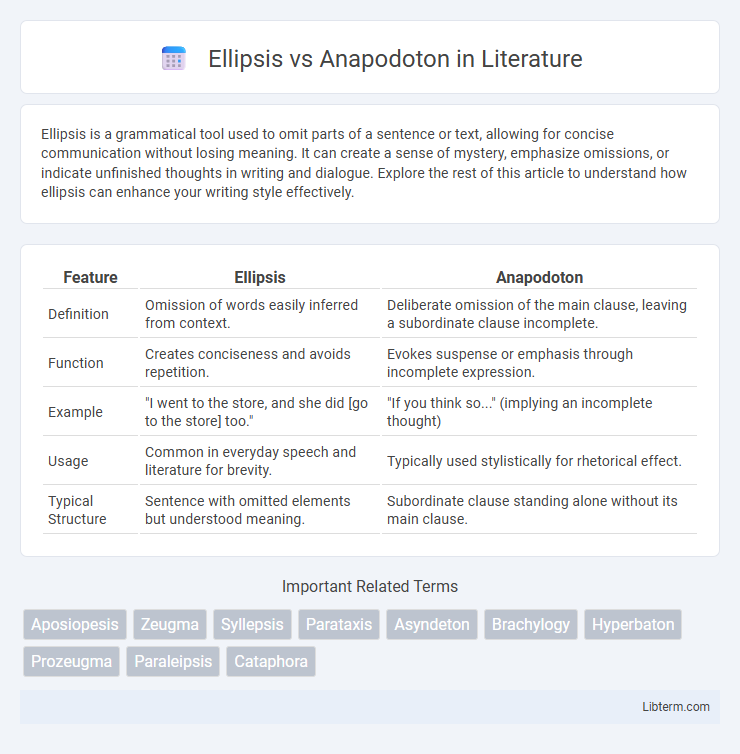Ellipsis is a grammatical tool used to omit parts of a sentence or text, allowing for concise communication without losing meaning. It can create a sense of mystery, emphasize omissions, or indicate unfinished thoughts in writing and dialogue. Explore the rest of this article to understand how ellipsis can enhance your writing style effectively.
Table of Comparison
| Feature | Ellipsis | Anapodoton |
|---|---|---|
| Definition | Omission of words easily inferred from context. | Deliberate omission of the main clause, leaving a subordinate clause incomplete. |
| Function | Creates conciseness and avoids repetition. | Evokes suspense or emphasis through incomplete expression. |
| Example | "I went to the store, and she did [go to the store] too." | "If you think so..." (implying an incomplete thought) |
| Usage | Common in everyday speech and literature for brevity. | Typically used stylistically for rhetorical effect. |
| Typical Structure | Sentence with omitted elements but understood meaning. | Subordinate clause standing alone without its main clause. |
Understanding Ellipsis: Definition and Usage
Ellipsis is a linguistic device that involves the intentional omission of one or more words in a sentence, allowing the meaning to be inferred from the context. This concise structure enhances communication efficiency and stylistic expression by avoiding redundancy while maintaining clarity. Understanding ellipsis enables better sentence construction and interpretation, particularly in conversational and literary contexts where implied meaning plays a key role.
Anapodoton Explained: Meaning and Examples
Anapodoton is a rhetorical device where a sentence is intentionally left incomplete, omitting the main clause, yet the meaning is understood from the context. It contrasts with ellipsis, which involves the omission of words or phrases within a sentence but retains the overall structure. Anapodoton examples include phrases like "If only I had..." where the result clause is implied but unstated, creating a sense of anticipation or unfinished thought.
Key Differences Between Ellipsis and Anapodoton
Ellipsis involves the omission of one or more words that are implied by the context, allowing sentences to remain grammatically complete, such as "I ordered pizza, and he [ordered pizza] too." Anapodoton differs by presenting an incomplete sentence that relies on the listener's familiarity with the omitted clause to understand the meaning, for example, "If you think I'll just--," leaving the thought unfinished. Key differences include that ellipsis maintains syntactic completeness while anapodoton intentionally leaves a clause unfinished, creating rhetorical effect or emphasis through implied content.
Common Functions in Literary and Spoken Language
Ellipsis and anapodoton are rhetorical devices that enhance economy and impact in both literary and spoken language. Ellipsis omits words that are implied by context, streamlining communication and creating a more engaging narrative or dialogue, while anapodoton presents incomplete sentences to evoke suspense or highlight emotional intensity. Both devices function to engage readers or listeners by relying on shared knowledge and encouraging active inference, enriching the expressiveness and dynamism of language.
Ellipsis in Grammar: Rules and Variations
Ellipsis in grammar involves the omission of one or more words that are understood from the context, enabling concise and efficient communication. Rules governing ellipsis require the retained elements to ensure clarity and preserve grammatical structure, often appearing in coordinated clauses or responses in dialogue. Variations of ellipsis include gapping, stripping, and verb phrase ellipsis, each following specific syntactic patterns to omit redundant information without losing meaning.
Anapodoton in Rhetoric: Forms and Effects
Anapodoton is a rhetorical device where a sentence is deliberately left incomplete, prompting the audience to infer the missing part, which creates an engaging and dynamic effect in discourse. Unlike ellipsis, which simply omits redundant words for conciseness, anapodoton relies on implied meaning to evoke curiosity and enhance emotional impact. This form encourages active listener participation and can heighten suspense or emphasize contrast within a rhetorical argument.
Recognizing Ellipsis vs. Anapodoton in Sentences
Ellipsis involves the omission of one or more words that are implied by the context, creating a concise sentence while maintaining meaning, such as "She can play the guitar, and he can too." Anapodoton refers to an incomplete sentence where the main clause is implied but not explicitly stated, like "If you think so..." which leaves the rest unsaid but understood. Recognizing ellipsis requires identifying omitted elements that are grammatically recoverable, while anapodoton detection focuses on noticing sentences that create tension or rhetorical effect by deliberately dropping the expected main clause.
Practical Applications in Writing and Speech
Ellipsis streamlines communication by omitting redundant words, enhancing clarity and pacing in both writing and speech, especially in dialogues and persuasive texts. Anapodoton creates suspense or emphasis by intentionally leaving clauses incomplete, often found in literary dialogue and informal speech to evoke a natural conversational tone. Mastering these techniques improves rhetorical effectiveness and reader engagement across various genres and contexts.
Famous Examples in Literature and Media
Ellipsis, the deliberate omission of words for concise expression, appears famously in Ernest Hemingway's "For sale: baby shoes, never worn," conveying deep emotion through brevity. Anapodoton, an incomplete sentence implying the rest, features in Shakespeare's "If music be the food of love, play on," where the consequence remains unsaid but understood. Both rhetorical devices enrich literature and media by engaging readers' inference and enhancing dramatic effect.
Tips for Effective Use of Ellipsis and Anapodoton
Ellipsis enhances communication by omitting redundant information while maintaining clarity, often used in dialogue or literary texts to create suspense or brevity; effectively use ellipsis by ensuring the missing elements are easily inferred from context to avoid confusion. Anapodoton, a rhetorical device where a main clause is omitted for emphasis or stylistic effect, requires strategic placement to provoke reader curiosity or highlight incomplete thoughts without sacrificing coherence. Both techniques benefit from careful consideration of audience interpretation and contextual cues to maximize impact and preserve transparency in meaning.
Ellipsis Infographic

 libterm.com
libterm.com